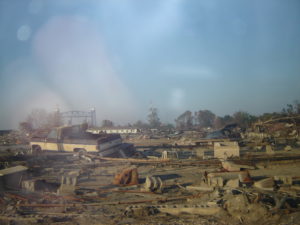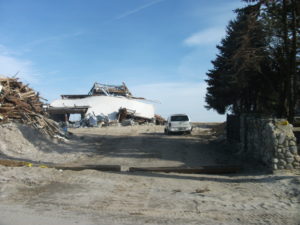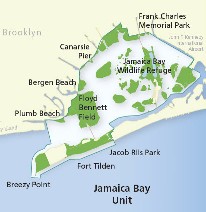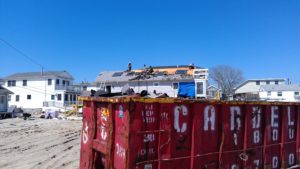This is a story both personal and political. On May 31, the American Planning Association hosted a wonderful retirement party for my last day on the job as Manager of the Hazards Planning Center. I have spent much of the past quarter-century helping to make natural hazards an essential focus of the planner’s job. The reasons are scattered all over dozens of previous blog posts, so I won’t repeat them here. It was a great send-off.
The next day, June 1, I was at home beginning the task of establishing my own enterprises in writing and consulting, including what shortly will be significantly expanded attention to this blog. In the rush to ensure that the transition for the Center would be smooth, I maintained a busy schedule in May, and I am aware this blog was somewhat neglected. Sometimes there is only so much time, and the blog has until now been a spare time project. That is about to change.
I spent much of that Thursday morning downtown. My wife had a dental appointment, and I had some minor issues to attend to. We paid a pleasant visit to Chicago’s Riverwalk and returned home on the CTA Blue Line. As we ate lunch, I watched the news on CNN. It was announced that President Trump would be announcing his decision on U.S. participation in the Paris climate agreement. I waited to see what would happen.
By now, I am sure everyone knows that he announced U.S. withdrawal from the accord. I remember two distinct impressions from the occasion. The first was that I was certain that nearly everything he said was wrong, that he was twisting the truth, and that his reasoning was badly distorted. The second was that, the longer he talked, and he talked for a while, the angrier I became. The sheer moral and political blindness of his position infuriated me. It has taken me three days to decide to write about it because I like to apply a reasonably broad perspective to the issues I address here. In part, I had trouble with that because I had planned a busy agenda in the opening days of my new phase of life to reorganize my home office, inform key contacts of my new e-mail address, and take care of the new business that accompanies “retirement.” (I put it in quotes because, for me, it mostly means self-employment.)
Trump’s announcement on the first day I spent at home felt like a slap in the face. The title of this blog, “Home of the Brave,” is meant to assert some claim to moral courage on behalf of those who are willing to pay homage to the truth. Trump finally had succeeded in embarrassing me as an American citizen. In my view, one of America’s claims to greatness in the world has been its willingness to educate its citizens and embrace honest science, and suddenly I was watching our president embrace brazen ignorance. There has been a tendency in some political circles over the years to glorify ignorance, but that tendency has seldom found its way into the Oval Office.
We join two other nations in the entire world that have not endorsed the Paris agreement. It is not hard to understand the problem in Syria, a nation that is basically at this point one huge battleground with a highly dysfunctional government that is slaughtering thousands of its own citizens. It would seem that Syria might have other priorities than negotiating a climate agreement. As for Nicaragua, what most people do not know is that Nicaragua, which has an abundance of both geothermal resources (also known as volcanoes) and tropical sunshine for solar energy, refused to accept the agreement not because it opposes progress in addressing climate change, but because the accord did not go far enough. That makes the United States of America the only nation taking exception to the very idea of combating climate change.
Trump does this in spite of the fact that American researchers have been leaders in generating the science that has documented the problem. Scientists quickly declared that many of Trump’s “facts” were either bogus or exaggerations of data chosen with an extreme bias toward his point of view. Moreover, in statements by administration spokespersons like Press Secretary Sean Spicer or U.S. EPA Administrator Scott Pruitt, no one was willing to answer explicitly reporters’ questions about what Trump truly believes about climate science. They talked around it, under it, behind it, and did all manner of verbal contortions to avoid simply saying whether Trump believes in the reality of climate change.
They prefer to stand behind the mistaken assumption that he is somehow protecting American jobs, but his views on this point are almost a half-century behind the times. Most coal jobs disappeared not because of climate regulations but because of automation that began nearly three generations ago. More recently, coal has been threatened economically by a surge of natural gas supplies as a result of fracking. One amazing aspect of this story, which includes the whole fight over pipelines, is that Republicans have tried very hard to have it both ways on the energy front. They have decried the decline of coal even as they themselves have supported fracking in a relentless bid to support all available options for developing American energy supplies. These various energy supplies compete with each other, and more natural gas at cheaper prices inevitably means less coal production and fewer coal jobs, a result that has little to do with environmental standards. It is called free enterprise. It is true that public policy tilts the scales in the energy industry, but public policy ought to do so with the future and the long-term best interest of the public in mind. In fact, a wiser administration might realize that now is an ideal time to begin to develop renewable energy sources in Appalachia to replace jobs that are unlikely ever to come back. Instead, politicians in places like Kentucky and West Virginia choose to play on fears and insecurity rather than offering a new economic vision that might actually improve the lives of workers. Unfortunately, this sort of political cynicism seems to be richly rewarded. That is the only explanation for a truly bizarre CNN interview by Jake Tapper with Sen. Rand Paul (R-Ky.) just ahead of Trump’s announcement. Setting up one straw man after another, Paul stated that the earth has undergone much more serious climate change than humans can cause. No one with a modicum of scientific education would not know that there have been wide swings in climate over geologic time (presuming you accept the theory of evolution), but they occurred over tens of thousands of years, not decades. Yes, we know about the Ice Age, Senator. It is not “alarmist” to note that climate change is occurring at a rate faster than nature has historically caused on its own.
Trump’s supposed defense of American jobs collapses in the face of the economic evidence. Renewable energy is producing new jobs as fast or faster than any other sector of the U.S. economy, as noted by people like Jeff Nesbit, who has a bipartisan track record of research on the issue. Trump outrageously claimed that other nations were laughing at us for being taken advantage of in the accord. In fact, they have respected American leadership in this sector, and if they are laughing at anyone, it is surely Trump himself, although I suspect that many are spending more time pulling their hair out in frustration and dismay at the direction he is taking. They are also preparing to move ahead without U.S. involvement, a stance not unlike that being taken by California and other states and cities with a more progressive view of the world’s economic future. My impression was that Trump, in obsessing about our nation being a supposed laughingstock, is revealing personal insecurities for which the nation is paying a high price. What, Mr. President, is the source of this persistent insecurity? You are wealthy enough to afford psychological counseling if you need it. I admit that you tapped into a good deal of voter insecurity, but you are leading your base nowhere. Do us all a favor and find them a vision for the future, instead of a nightmare based on a flawed vision of the past.

Scene from New Orleans in November 2005 after Hurricane Katrina
So let me circle back to what so offended me personally about being confronted with this public policy disaster on my first day after leaving APA. Little more than a decade ago, following Hurricane Katrina and the Indian Ocean tsunami, with many years of planning experience behind me in the disaster arena, I realized that my position at APA afforded me a truly rare opportunity to shape planning history by refocusing the profession’s attention on the numerous ways in which planners could use their skills and positions in local and state government, consulting firms, and academia, among other possibilities, to design communities in ways that would save lives and reduce property damage. I was determined to devote the remainder of my career to helping make that happen, with the help of numerous experts and veteran planners who shared my vision of those opportunities. Uniquely, however, I was in a position to shape the agenda of the American Planning Association on behalf of its nearly 40,000 members to provide the resources, research, and training those planners would need to attack the problem.
By 2007, we had persuaded the Federal Emergency Management Agency, still reeling from perceptions of ineptitude in the response to Hurricane Katrina and other events, to underwrite a study of how planners could better incorporate hazard mitigation as a priority throughout the local planning process. The result, Hazard Mitigation: Incorporating Best Practices into Planning, has had a growing impact on community planning since its release in 2010. It had been truly heartbreaking to see communities so poorly prepared for natural disasters that more than 1,800 Americans lost their lives in Mississippi and Louisiana as a result of Hurricanes Katrina and Rita. We could do something to change that. FEMA has since then incorporated this concept of integration into a variety of guidance, and so has the State of Colorado. Things are changing.

Scene on the New Jersey shore after Hurricane Sandy, February 2013
We also in 2010 persuaded FEMA to underwrite another project that would rewrite our 1998 guidance on planning for post-disaster recovery, and the result in late 2014 was not only another Planning Advisory Service Report, Planning for Post-Disaster Recovery: Next Generation, but a substantial collection of online resources to supplement that report. Among the key recommendations for communities was the idea of planning ahead of disasters for major policy decisions that would govern the post-disaster recovery planning process so as to expedite wise decision making. That project has also proven highly influential.
Throughout this all, the growing impact of climate change was making itself evident. This is not just a matter of jobs. It is a matter of whether our President believes in making his own nation, his own citizens, safe in the face of natural disasters that, in many cases, can be made worse by climate change. This is not just a matter of sea level rise increasing the impact of storm surges produced by tropical storms. It is also a matter of increased susceptibility to prolonged drought in many parts of the U.S., and increased susceptibility to wildfire, as well as more extreme high-precipitation events that can exacerbate urban and riverine flooding. That is why APA and the Association of State Floodplain Managers, in a Regional Coastal Resilience grant project supported by the National Oceanic and Atmospheric Administration, is working with pilot communities on both the East Coast and the Great Lakes. The Great Lakes do not experience rising sea levels, but they do experience fluctuating lake levels and greater weather extremes that can raise the costs of natural disasters in coming decades.
All that brings us back to the President’s admittedly alliterative statement that he was putting Pittsburgh ahead of Paris. That’s a nice sound bite, but it makes no sense. For one thing, Pittsburgh voters no longer look to coal and steel mills to secure their economic future. For the past 30 years, Pittsburgh has moved ahead with a new economic vision based on industries of the future. Almost surely, that was the reason Hillary Clinton won 75 percent of the vote in Pittsburgh last year, although Trump won Pennsylvania by a narrow margin, racking up most of his victory in rural areas. Pittsburgh’s economic growth model may not be perfect (what big city is?), but it is better than most. And it certainly is not tied to President Trump’s retreat from progress on climate change.
Nowhere in the administration message did I hear any acknowledgment of the job growth that is tied to our leadership on climate change, and the opportunities that may be sacrificed to the President’s flawed analysis of who is supposedly laughing at us. Technological and scientific leadership have been the lifeblood of America’s prosperity. We are now retreating from that prospect at what may be a high cost in the future unless we turn this ship around again. Nowhere did I hear any acknowledgment of the cost to communities in lost life and property safety as a result of ignoring warnings about the impacts of climate change.
On one level, the priorities for which I have worked for the last 25 years may not matter much in terms of my resentment at seeing so much of this work seemingly undone on the day after my retirement from APA. Trump also may ultimately have far less impact on the subject than he intends. But on another level, I was just one more contributor to a great push by millions of Americans toward that safer, more prosperous future that remains possible despite this grand presidential blunder. Maybe the Nicaraguans, who are not part of the Paris accord, are right—we should do far more, not less. But we certainly should not be following the lead of President Trump. He has dramatically gotten it all wrong, and we must all say so as forcefully as we can.
Jim Schwab










